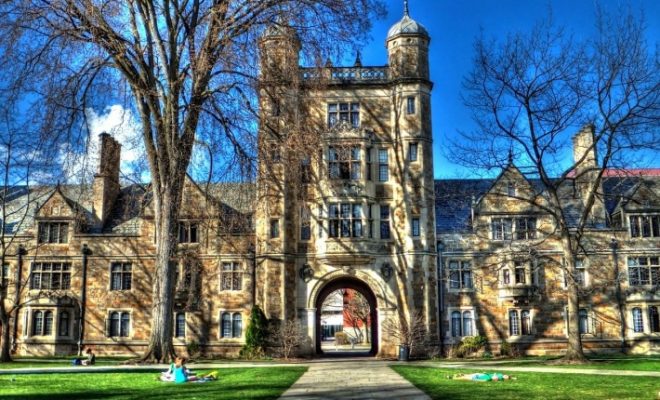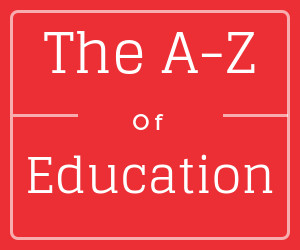How to Revolutionize the US Educational System

Right now, free public education in America comes at a price.
Whenever the country hits turbulent financial times, as it did during the Great Recession, it takes its toll on the quality of education available in our K-12 schools—and it can take decades for the resulting deficiencies to rear their ugly heads.
When town and city administrators curtail the hiring of new teachers, or force the retirement of older teachers, class sizes increase. The teacher-to-student ratio expands accordingly, meaning less face time per student, reducing the overall effectiveness of educational institutions.
An economic crisis does not just affect school budgets. Financial difficulties within students’ families also play a huge role in the educational problems of the United States. With more parents scrambling to make ends meet, there is less parental involvement with their children. As a result, students may become unmotivated and slack off on assignments. They may become problematic at school, meaning more time and effort from school administrators, leaving less time to improve their various systems.
Most American homes are dual-income, with both parents working one or more jobs to try to meet their financial obligations. There are also many single parent families, where the time for work and domestic tasks takes away from one-on-one educational work with children. In nearly every family situation, the time parents have to give their children any type of grounding in basic knowledge is severely limited. The result is children starting school without much of the very basic knowledge children had in generations past. Without that early foundation on which to build, children find themselves forever running at a deficit.
Furthermore, testing regimens for our children are anything but uniform. Some children are over-tested to an extreme. States like Massachusetts may be acclaimed for their stringent policies and standardized testing, but that level of stringency does not necessarily carry over to other states. In fact, many other states are not nearly as rigorous in their own testing procedures. Instead, they would rather do only what they have to do to receive federal education funds, and nothing more.
This level of inconsistency then becomes yet another problem for students. Given the economic climate of the nation, many students may find themselves moving from state-to-state as their parents pursue employment or better jobs. Inconsistency among state standardized testing procedures may result in students who have relocated suddenly finding themselves under a lot of pressure to do better than what was required in their previous school.
The Difference between Then and Now
In generations past, children starting school came into the system with far more knowledge already in hand. They knew their letters, they knew how to count, and some of them already knew the fundamentals of reading. This, of course, stems from the fact that most families had a parent who stayed home during the day and was therefore able to spend more time with the child. There were also fewer electronic distractions from the basics of reading.
Teacher retention is difficult now, and this also stems from economic factors. A number of the accelerated teacher certification programs, such as weekend and online programs, have good intentions but are turning out teachers that are unprepared to the meet the challenges that they soon will face in troubled classrooms.
Although these teachers are inexpensive since they are brand new and have not worked their way up to better pay scales and benefits, they are more likely to jump ship and leave the school system instead of staying to nurture their profession. Of course, the next group of teachers to replace them is new and inexperienced, too, but provides fresh bodies in the classrooms at an inexpensive level – so the cycle repeats itself. This is good for the budget, but not so good for long-term performance, morale, and achievement.
Certainly, the economic situation affects the task of balancing budgets, by the school system, government entities, and parents. Conversely, more money does not necessarily mean more improvement – but not enough causes a host of its own problems too.
America spends more per student than any other nation in the world, and yet we see mediocre results. With this kind of money being pumped into the system, why are our school systems in the state that they are? There’s no arguing that our schools need to be well funded in order for our children to succeed, but clearly our schools need to do a better job utilizing the funds that they already receive.
When it comes to school reform, something’s got to give. What is it?
Education Reform 101
Is there a winning mindset for successful school reform?
When considering school reform, many administrators may be at a loss for how to think of their schools.
It may sound cold and clinical, but it’s advantageous for administrators to think of their schools as businesses. Think of how it would be if the structure of the school reflected the business model. We would work from the assumption that students in the school system are customers, schools are the businesses, teachers are the employees/supervisors, and the administrators are the CEOs.
In any business, the customers’ needs always come first. The reputation for customer service is the best advertising a business can receive. Keeping this savvy business strategy in mind, the business of the school should be to create learning opportunities that lead to greater academic achievement. If educators make lessons fun while adhering to the curriculum, the graduation rate will increase dramatically. If children feel safe and entertained, they will want to come to school. It is the educator’s task to make sure students learn to love to learn, while it is the administration’s task to support their efforts.
The most critical question administrators must confront is: where do we begin?
Well, let’s get this out of the way: tackling several goals at once is not a good idea. It seems noble, but when trying to start reform in a complex environment such as a school, administrators need to focus on one task at a time. When making decisions, the administration needs to complete all steps of the reform in a sequential order, using a strategic way of thinking.
In some cases goals can be independently accomplished. Departments will be able to achieve short-term goals while accomplishing the larger goals. In education, the improvements that matter the most are those that directly concern children. In order to create the necessary improvements, school districts must be reformed in ways that will sustain change. The ability of a school district to sustain reform should be the highest priority for the superintendent and the board of education.
How can schools sustain reform? First, administrators must come to an agreement regarding issues that have made it necessary for school reform to take place. They need to be open and honest, and avoid blaming others for the issues that exist. All individuals directly and indirectly involved in the school reform must share a common vision.
Administrators should try to come to a consensus regarding the purpose of education and the roles of the faculty and staff. They also need to agree on the rules and guidelines that will support the implementation of the reform, while respecting cultural beliefs of the faculty, staff, and students. Finally, administrators must communicate the current issues of the school and the vision for the future to stakeholders. Those who support and participate in reform need a clear vision of the common goal. Administrators must paint a reform picture that alleviates fears, and entice all to buy into the vision.
Communication is the key to running and sustaining a successful school when creating concrete reform. All participants and key administrators must agree to communicate with each other their understanding of the school reform, including their concerns. The administrators and participants must have a shared understanding of the issues the district faces, as they must learn to articulate, analyze, and explain the issues in a similar way.
There needs to be a common vision concerning students, schools, and the allocation of resources. Administrators must also anticipate new trends and issues preventing reform. Once the obstacles have been identified, it is the duty of the administrator to articulate these trends and issues to the powers that be, i.e., superintendents and school board members. Finally, the most important communication between administrators and staff is how to create reform that provides a quality education for all students.
Communication must also take place among the school district, superintendents, and the board of education in an intentional and ongoing manner. They must continuously reflect in an open and honest way on the effectiveness of the reform, and successfully communicate between departments in the case of promotions, retirements, or sudden resignation.
When creating school reform, administrators should consider working with community members. Community members and parents have a lot to contribute when it comes to school reform and they should be encouraged and allowed to do so. Parents and educators undoubtedly have a genuine concern for the needs of students. Why not place the important decisions concerning our students in the hands of the people that have the children’s best interests at heart?
Administrators should also consider teachers as a major part of school reform. Reform is considered a success or a failure based on the students’ performance, but teacher performance is inextricably linked to student performance. Through positive teacher-student relationships, genuine learning can take place in the classroom. Teachers know their students and the educational practices that work best in their classroom.
In schools across the nation, the people in the best positions to create positive outcomes have little to no control over the changes that are made and how they are implemented. Too often, the most critical decisions concerning the educational system are made by people without the capacity to understand the inner workings of the individual school and what it takes to ensure no child is left behind. So the challenge here is for those who the most power to make changes connect with those who are in the trenches with the students.
Will the “slow and steady” approach work for education reform?
Speaking of mindsets, the Japanese have a philosophy of continuous quality improvement.
This philosophy is called “kaizen,” which they apply to many areas of their life. Kaizen is the idea that one does not need to wait for something to be broken in order to fix it. Rather, one should always look for opportunities to improve upon current processes, making things incrementally better as time passes. This drive for continuous improvement should apply to our educational system; we need to constantly be striving to make things better, reevaluating how we do things, looking at the results we are achieving, and taking steps to improve things incrementally.
In the same way that kaizen theory speaks to improving life in general, we should apply the same principles to U.S. K-12 education. We must consider ways in which our educational system can and should grow, change, and continuously improve in ways to best serve our children. In order for the United States to continue to progress toward a knowledge-based society, it is necessary to reform and streamline our education system to enable the development and assimilation of information as knowledge. Our schools are the primary institutions to facilitate transference and conversion of information into students’ knowledge base. It is our duty to keep a watchful eye on the schooling processes, and to change educational policies and practices to ensure improvement.
That said, over the past century, many reforms have taken place throughout the U.S., and on a continuing basis. Despite the constant need for change, very few, if any, of these reforms really made their way to the school level. Most of the initiatives that led to reform originated from dynamic leaders who were capable of implementing these changes in an extraordinary fashion, despite the presence of various radicals in strong opposition to these changes. However, as soon as the leaders moved on to their next challenge, these radical individuals returned to their old ways. The reform was diminished, and eventually there remained no trace of it.
Study after study has shown that the American educational system is not just in need of regular, continuous quality improvement. Something very different is needed since the system is in a state of fundamental disrepair. Our children are performing poorly compared to other developed countries. Children from low socioeconomic backgrounds are performing even worse.
Continuous improvement on its own may not be the all-encompassing solution for our educational system, but we definitely need to take a long-term approach to school reform instead of looking for a quick fix.
Why education reform should not have an end date
The word “reform” comes with the connotation of something with a start and end date. There are reformation eras in history, and policies, and initiatives. The problem with thinking of reform, particularly school reform, on a timeline is that the most successful reform attempts are ongoing.
People involved in the piloting stage of school reform often see what they are doing as something limited by time. Other stakeholders likely share this view, or are of the opinion that the work will stop when the reform money runs out, or that, the new reforms won’t take hold. This generally leads to fragmentation, or a lack of a coherent approach to reform, and as a result, reform efforts often end up sidelined. Unfortunately, this circumstance runs contrary to the realization of in-depth, sustained school reforms.
The cyclical turnover of superintendents and school board members makes it difficult to ensure that others will continue effective systemic reforms begun by one board and superintendent. New superintendents and new school boards often want to make their marks by initiating changes rather than sustaining the strategies created by their predecessors.
This is often the case even when evidence suggests that existing programs are the ones that need to be sustained to meet long-term goals, such as closing the achievement gap or getting all students to proficiency. The new leadership appears to forget that there are no quick fixes or short term reforms that guarantee continuous improvement in student achievement, as they jump to exchange existing efforts for improvement with new ones.
The process of school reform can become very lengthy and on the whole it is expected to stretch across a period of several years. Ironically, school districts are placed under tremendous pressure to turn a new page each year, allowing for only a fraction of the time required for any reform plan to produce results. This is sometimes part of a government ploy when budget cuts are enforced with little notice, or a result of resentful parents streaming to the authorities in opposition to some aspect of the an existing plan.
The process of annual makeovers comes at substantial costs to the states that are likely already operating on limited funds. Cost is not the only issue however. By reinventing the system each year, educators, teachers, and principals alike, have no chance to come to terms with the details of any particular plan before it’s time to implement the next one. As a result, educators are never fully versed on any plan, in effect making the process of reform fruitless.
The role of the school district is to take a long-term approach, define, and articulate the school reform agenda for the district, as they are a crucial source of leadership in implementing and sustaining reform. Their role should be to develop a framework by which sustainable reforms can be measured even if there is a turnover of staff.
A school reform framework should include four key points:
- improving student achievement
- fiscal accountability
- increasing organizational effectiveness
- building and improving relationships with staff and the broader community.
This framework provides an agenda that the school board and staff can work from and use as a checklist to measure the success of reforms. It also means that when recruiting new staff you should look to hire people whose vision matches the already defined vision of the district, an important factor when it comes to sustaining change over time. Reform then should become a permanent goal of every school system, not something that can be plotted out nicely on a calendar.
How much does money matter?
Often, we worry over how much money our public schools are receiving, right? Are these funds enough to serve the schools? And if they are, why are governments/districts/schools mismanaging the money?
One glaring issue is that we run into a lot of problems with tracking expenditures for schools.
We’re at the point where many investigators have requested new methods to determine expenditures for schools.
The good news is that manufacturing theorists have pioneered completely new expenditure models that include costs that are activity and program-based. These models also help form fiscal data so that strategic decision-making becomes easier for schools that need to use the data.
In several reports, researchers have demanded new methods of expenditure recordkeeping as a means to modify district strategy. This is to identify the real expenditures involved in individual schools, programs, or services.
The models that have been created are different in terms of which categories they’ve used, but all of them propose assigning a larger percentage of costs to specific types of students and schools.
Reforms relating to accountability have focused not only on performance inequalities between white students and students from minority group backgrounds, but also between students having different needs that result from disability, poverty, or limitation in English proficiency. Many policymakers stress that the first stage in tackling these achievement gaps is to align fiscal policy with student needs. But currently, when policymakers refine their established funding formulas to fulfill the needs of different students, they don’t have any evidence to back up their hunches.
A state policymaker who wants a particular demographic of student to receive funds is going to have a lot of trouble because no baseline data exist on current expenditure in regard to each type of student within their own districts or other schools within other districts. School districts in most states do not fully track costs by student type or to the school level. Even where these data are tracked, they are not accessible from published works for policymakers attempting to pin answers down.
Just as challenging is the difficulty comparing states when it comes to funding. There aren’t any accurate ways of defining or reporting expenditures influenced by student needs. Because of this, it is impossible to compare data between states. Furthermore, policymakers have not yet figured out how to flow funds from one level of government to the next. For example, funds may be designated by the federal government for students living in poverty, with the goal of enhancing expenditures at schools having high concentrations of poverty. However, by the time funds are dispersed through state and local allocation streams, they may not reach their intended target.
Finally, no much documentation exists regarding different decisions for structuring assigned allocations and the way those decisions relate to policy aims. Put in other terms, allocations meant for students having limited English proficiency (LEP) might be realized as a fixed dollar amount per LEP student, reimbursements for the spending on bilingual education services, apportionment of staff full-time equivalents (FTEs) to high-needs schools, or as funds for other areas. Research has not yet figured out how these different decisions influence either what is finally spent per pupil or how efficiently that funding reaches the intended students.
The bottom line? When it comes to knowing how to spend money, the government, states, and schools are lost.
School Reform on a Budget
On a smaller scale, reform efforts can run into other problems as well.
A major mistake many reform groups make is to table educational reform efforts because the expenditure does not fit into the school budget. If children are America’s most precious commodity and the focal point of the nation’s educational system, then the lack of funding is no excuse to skip reform efforts. If we can’t commit money to our K-12 students, how can we expect them to rise above their circumstances?
The old business adage is that you have to spend money to make money – and that should be the mentality when looking at struggling schools or districts that need, sometimes costly, reform. By smartly investing the money, even just in a few key areas, schools will see a return on that reform investment in the way of more successful, higher achieving students. And really – school reform does not need to cost a fortune to make a difference.
In truth, many school reform efforts are cost-effective and can be implemented by resourceful educators. When there is a lack of money, reform is contingent upon the faith and commitment level of the faculty and staff. No need to waste money on model programs and unsubstantiated trends. Instead, reform groups will have to work diligently and efficiently to implement the chosen reform efforts properly and effectively.
So where should the money go?
When school reform is needed and schools have limited resources, spending money on curriculum can be intimidating, but it is a vital place to put money because it makes a huge impact on student outcomes. The curriculum chosen will need to be a good fit for both teachers and students. Math and reading should be the first concern, because they are the building blocks for other subject areas, as well the most frequent measure of future success. Success in these two areas bode well for success in other subjects at all grade levels.
Teachers’ professional development is a key factor for successful school reform as well. When analyzing reform budgets, it is important to set aside money to hire teachers with the ability to create and teach in-service professional development programs. Training staff and educators internally will save the school money, and will give the teacher/expert a feeling of usefulness. For instance, a teacher with 30 years of experience and a demonstrated ability to obtain amazing results from her specific teaching strategies might create a professional development seminar to share her expertise. This saves the school an enormous amount of money, and saves the administrator the trouble and cost of hiring a consultant. Another low-cost/no-cost option is to hire professors from neighboring colleges and universities to provide professional development services to your district as a form of community service or to fulfill requirements to obtain or maintain tenure.
In the end, schools operating with limited funds to support reform efforts will need to be both resourceful and creative in order to effect positive change. Forward thinking leaders, committed and imaginative teachers, and a supportive community can contribute to change that improves the educational experiences of our children.
Pay teachers right: why you shouldn’t leave them in the dust
School reform is never easy. When sweeping changes are decided upon and implemented, everyone must fully participate in order for students to benefit from the changes and certainly not to suffer during the transition. Part of providing that stability for students is through a strong front of teachers that remain at the school during the sometimes turbulent reform process.
Here are some useful tips that will help you preserve teaching jobs while reforming schools:
- Remember – a high teacher turnover is expensive. It is a simple fact of life that high staff turnover can create instability and have a negative impact on efforts to establish a consistent learning environment for students. High staff turnover is also quite costly, particularly when the recruitment of teachers, and then the training of new teachers in the intricacies of the reform effort are considered.
- Pay attention to who you hire so that you can reduce teacher attrition. Give more effort and support to the recruitment process for teachers at the outset as schools and districts initiate reform efforts. Hiring teachers who “fit” reform goals will likely reduce teacher attrition. Still, new teachers need more support. Even teachers who ostensibly have the skills and attitudes that align with reform goals will need mentoring and other supports as they begin their jobs. Make every attempt to reduce the debilitating rate of turnover.
- Become creative with spending on new resources. Inevitably, a major factor for sustaining reform is having the money to do so. Most efforts now are centered on how to make the most of current funding and utilizing money effectively in order to maximize the positive impact of reforms, rather than how to access untapped resources. Despite the dearth of new money, it is possible to free up cash through alternative means of spending.
An extreme proposal to accomplish this is to reduce staffing to the absolute minimum. For example, a school with 500 students would have 20 teachers and 1 principal. Approximately $1 million could become available, depending on how many education specialists (regular and categorical) and instructional aides worked within the school. This is radical option, and there are other, less extreme ways to change the way money is spent, to include increasing class sizes, spending less on upgrading technology, and eliminating some programs.
The key, however, is to look in detail at all financial outlays, measure them according to the extent to which they contribute to the goals of the school reform, and rank them according to how well they do this. This will enable schools to break down spending into its core components and work out what is necessary and what can be cut during the process of change in order to better implement their improvement strategy. This is particularly important in times of austerity, when elements that are not essential may have to be reduced or cut in order to help drive reform, no matter how popular or long-standing they may be.
Spending money on non-essential areas does support school reform efforts. Prioritizing what money is spent on does not automatically mean cutting all non-academic projects. What gets cut will depend on the goals of individual schools. This should be a workable situation, as long as the school is still accountable to the state and the district for shifts in expenditures. An understanding that cutting teaching jobs can actually be detrimental to reform is important though, instead of just looking at the numbers on a piece of paper.
Optimizing Education Reform
Here’s a tip: give the reform a vision.
Instructional leadership offers administrators the opportunity to create a shared vision of learning for the entire school environment – allowing both educators and support staff to get behind a common goal. That common goal is most often articulated in the form of a school mission statement, which must be built effectively in order to be compelling.
What are the characteristics of a good school mission statement?
- Academically Focused
A school’s mission must be academically focused, as after all that is the primary function of the school environment. While there are other functions that a school serves, other roles that it plays, the academic growth of the students is where it all starts and where it should ultimately lead. The mission statement serves as a reminder to all members of the school community that strong academics are the prize.
- Objectives are Clearly Expressed
In order for all stakeholders to have the opportunity to participate in the school’s model, express the objectives clearly and in writing. The language has to be clear and something that everyone can understand, from teachers and administrators to parents and support staff. Students should also be able to access the mission statement so that they can become participants in their own education.
- Clearly Displayed
A mission statement does no one any good if it’s kept locked up in the office or just posted on a web page. In order for a school’s mission statement to be of any use, display it proudly all over the school. In hallways and on distributed materials, discussed in classrooms and assemblies. If a school wishes for its mission statement to drive the school culture, then make it part of the school environment and conversation.
- Present in the Classroom
Besides being displayed and talked about in the school, the mission statement should be the primary driving force for teachers when they are planning and implementing lessons. This is something that can take some acclimation for teachers, who might be reticent to change their focus when planning lessons. However using the school’s mission as a focus and a trigger point will help students to have a unified educational experience, which will help them to solidify their learning across the school setting.
- Actively Modeled
In addition to all of this, the schools’ top administrators must expertly articulate the mission. If the mission has an academic focus, then the administration needs to actively back that up. Stakeholders will have a hard time pushing the mission of the school if they believe that there is a lack of integrity in the execution of it, for example if the mission pushes academics, but the school more actively focuses on sports or societal concerns. Of course even with that academic heartbeat that’s driving the school’s mission, there will continue to be ancillary projects and activities going in in the school, but with that the pulse must still be academic, and that pulse is derived from the actions of administrators.
Applying Research to Mission Building
Instructional leaders should apply research to their mission building strategies. One key way to do this is to ask questions about the mission statement as it is in development and then later as it is implemented.
- Are the goals clearly articulated and easy to understand?
- Are the goals visible throughout the school environment?
- Are they familiar with all of the stakeholders in the school?
- Do the goals apply in the day-to-day activities at the school?
- Do instructional leaders consistently and actively reinforce the misson’s goals?
- Do all stakeholders in the school support the mission?
The Importance of the Mission Statement
Direction-setting in the school environment is an essential aspect of instructional leadership. Framing and communicating the school’s goals through a mission statement is the perfect way to communicate the direction and focus of the school environment. Clear, measurable and time based goals are at the heart of the school experience. When these goals are communicated and achieve buy in from stakeholders within the school environment, then the school’s mission becomes attainable. Too often goals are not active drivers in the school community, but rather are sidebar considerations that don’t get much attention from school personnel. The mission is a wonderful tool to help create an effective school environment.
Nearly every school has a mission statement, and it can be a powerful tool that helps to codify and give direction to the enthusiasm, passion and expertise that educators bring to the classroom. Or it can be a jumble of letters that are posted on the wall of the office and left unnoticed. The choice is up to the leadership of the school environment. One thing that administrators must realize is that good goals, good mission statements that are well articulated and actively communicated, offer the possibility for radical change and success.
Why even bother?
None of these considerations are easy. So is it worth trying?
Schools have an interesting history in this country. Historically, they have played a significant role in helping communities evaluate issues concerning child welfare and eliminating situations that impede children’s progress. During the Great Migration of 1880–1924, a huge number of impoverished children moved into the schools of American cities. The majority of immigrants were poor and undereducated.
Social reformers and policy makers pressured public schools to work toward improving children’s lives. Many schools devoted themselves not only to educating poor children, but also to providing them with proper nutrition and other amenities required for healthy living. Teachers devoted their time to teaching English to immigrant students. Many schools offered non-academic services, including school nurses, gyms, playgrounds, and mid-time meals or lunches for poor students.
Some schools also started offering night classes for parents to help them learn English and other important parental skills that could assist them in caring for their children. Many schools encouraged teachers to improve school-parental ties by visiting students’ homes and instructing parents on how to offer a better learning environment for children at home. However, such initiatives faced a certain degree of opposition from parents who were not ready to leave their ethnic and racial identities.
A major hurdle was the economic impracticability of sustaining such child welfare activities. Most of these initiatives were criticized as “socialistic,” but many children enjoyed the benefits of programs intended to improve the overall situations of children and their families. Children not only experienced better living conditions; they also gained many opportunities to rise out of poverty. As a result, more immigrant children started coming to school regularly.
Ever-increasing fiscal burdens on schools created by child well-being initiatives caused political opposition and social criticism. In order to reduce costs, many state governments withdrew funding for social services offered by public schools. As a result, the upsurge of underprivileged children in the late 1980s and early 1990s was met with reduced and nonexistent services emanating from schools.
The depressed socioeconomic conditions of underprivileged families were responsible for undermining the learning process and academic achievement of many children.
We’re in different times these days. Nowadays, when it’s critical to have great schools and involved parents, both are overloaded and unable to help students reach their full potential.
As educators, we cannot do much about parental involvement—except encourage it. (For those of us who have children, of course, we can also be active parents ourselves.) However, we do have more impact over the reform efforts of our schools, even though we often think we don’t. At the very least, we can begin with awareness and taking an active role in our schools’ reform efforts.






